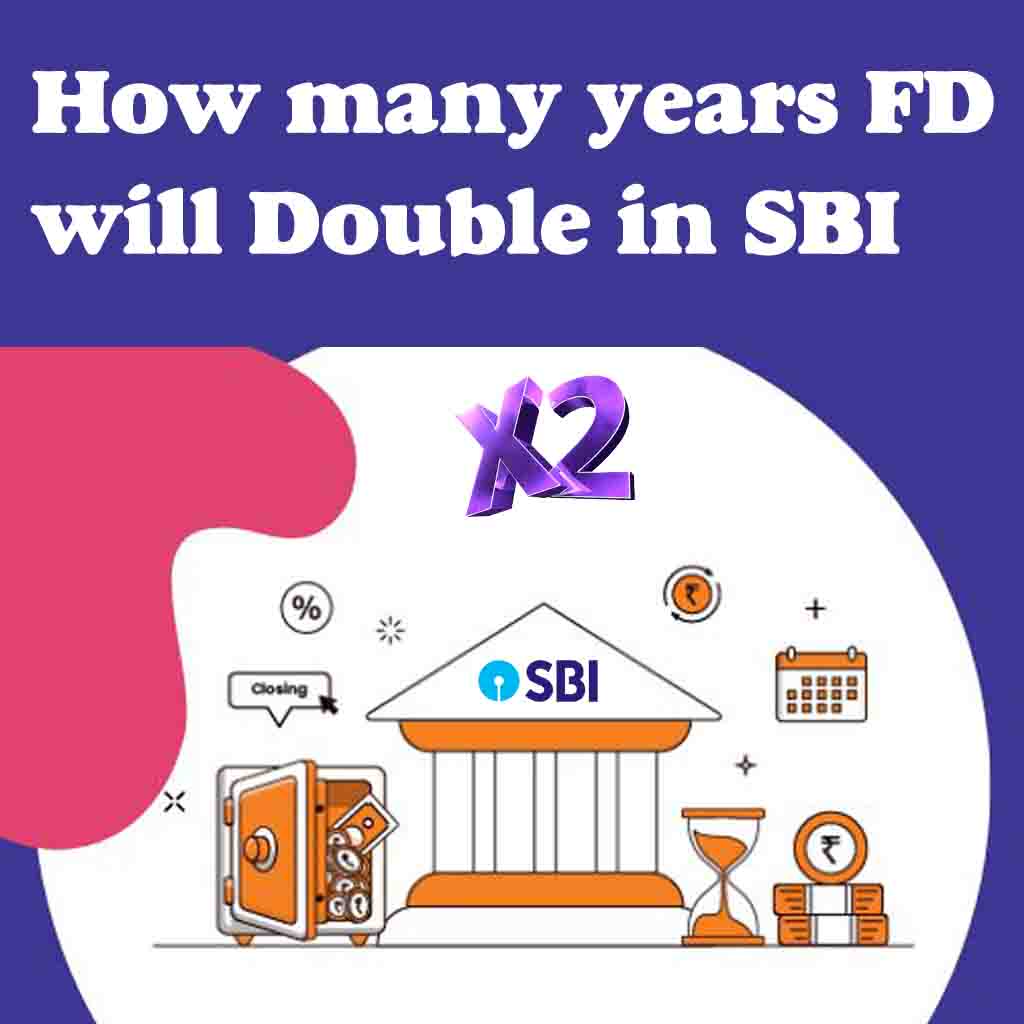How many years FD will double in SBI - Digiforum Space
Share
Facebook X LinkedIn Tumblr Pinterest Pocket Skype Messenger Messenger Viber
Fixed Deposit (FD) Doubling Period in SBI: A Comprehensive Analysis
How many years FD will double in SBI? : Fixed Deposits (FDs) are popular investment instruments in India known for their stability and guaranteed returns. State Bank of India (SBI), being the largest public sector bank, offers attractive FD schemes to its customers. One important aspect that investors often consider is the time it takes for their FD investment to double. In this article, we will explore the factors that determine the doubling period of FDs in SBI and provide a comprehensive analysis of the approximate number of years it takes for an FD to double in SBI.
Factors Affecting FD Doubling Period : Several factors influence the doubling period of an FD in SBI:
- Interest Rate: The interest rate offered by SBI on FDs plays a significant role in determining the doubling period. Higher interest rates generally result in a shorter doubling period, while lower interest rates prolong the period.
- Compounding Frequency: SBI offers different compounding frequencies, such as monthly, quarterly, half-yearly, or annually. The more frequent the compounding, the shorter the doubling period.
- Tenure of the FD: The duration for which the FD is held also affects the doubling period. Generally, longer tenure FDs have a shorter doubling period compared to shorter tenure FDs.
- Premature Withdrawals: If a premature withdrawal is made before the completion of the FD tenure, it can impact the doubling period. Any premature withdrawal may result in a reset of the interest calculation, affecting the overall growth of the investment.
Calculating the Approximate Doubling Period
To calculate the approximate doubling period of an FD in SBI, we can use the rule of 72. The rule of 72 is a simple formula used to estimate the time it takes for an investment to double based on the compound interest rate.
Doubling Period (in years) = 72 / Interest Rate
Rule of 72 Examples
The Rule of 72 is a simple and useful tool that helps estimate the time it takes for an investment to double based on the compound interest rate. Let’s look at a few examples to illustrate its application:
Example 1) : For example, if the interest rate offered by SBI on an FD is 8%, the doubling period can be estimated as follows:
Doubling Period = 72 / 8 = 9 years
Please note that this is a simplified calculation and provides an approximate estimate. The actual doubling period may vary depending on the compounding frequency and other factors mentioned earlier.
Example 2): Savings Account Suppose you have a savings account that offers an annual interest rate of %. To estimate how long it would take for your savings to double, you can use the Rule of 72:
Doubling Time = 72 / Interest Rate Doubling Time = 72 / 3 = 24 years
In this case, it would take approximately 24 years for your savings to double at a 3% interest rate.
Example 2: Fixed Deposit Consider a fixed deposit with an interest rate of 7.5%. Using the Rule of 72, you can determine the doubling time:
Doubling Time = 72 / Interest Rate Doubling Time = 72 / 7.5 = 9.6 years
Based on this calculation, it would take approximately 9.6 years for your fixed deposit to double at a 7.5% interest rate.
Example 3: Investment Portfolio Suppose you have an investment portfolio that historically generates an average annual return of 10%. Applying the Rule of 72, you can estimate the doubling time:
Doubling Time = 72 / Interest Rate Doubling Time = 72 / 10 = 7.2 years
In this example, it would take approximately 7.2 years for your investment portfolio to double with an average annual return of 10%.
Factors to Consider
While the rule of 72 provides a rough estimate, it is essential to consider a few factors that may affect the actual doubling period:
- Changes in Interest Rates: Interest rates are subject to change based on various factors such as market conditions, RBI policies, and inflation. It’s crucial to monitor the prevailing interest rates and their impact on the doubling period.
- Tax Deductions: Interest earned on FDs is subject to taxation. The tax deducted at source (TDS) can affect the overall returns and may impact the doubling period. Ensure to account for any tax implications when estimating the doubling period.
- FD Renewals: Upon maturity, investors often choose to renew their FDs. The renewal interest rate may differ from the original rate, which can affect the doubling period of the investment.
- Individual Financial Goals: The doubling period of an FD should align with your financial goals and investment horizon. Consider your specific financial objectives and investment timeframes when evaluating the doubling period.
Additional Reading
- What is rule of 72 Calculator
- Tax (TDS) on FD Interest
- Credit Card against FD
- How to add money in Paytm FD
- Fixed deposit double in 5 Years
Conclusion
The doubling period of an FD in SBI depends on various factors such as the interest rate, compounding frequency, tenure, and premature withdrawals. By using the rule of 72, investors can estimate the approximate doubling period of their FDs. However, it’s important to consider potential changes in interest rates, tax implications, and individual financial goals when planning an investment in FDs. SBI’s FD schemes provide a secure and reliable investment option, and understanding the doubling period helps investors make informed decisions based on their financial requirements.
FAQs – Frequently Asked Questions
Q: How long does it take for a fixed deposit (FD) to double in State Bank of India (SBI)?
A: The time it takes for an FD to double in SBI depends on various factors such as the interest rate, compounding frequency, and tenure of the FD. It can range from a few years to several years.
Q: What is the rule of 72, and how is it used to estimate the doubling period of an FD?
A: The rule of 72 is a simplified formula used to estimate the time it takes for an investment to double based on the compound interest rate. To calculate the doubling period, divide 72 by the interest rate offered on the FD. However, it provides only an approximate estimate and may not account for other factors like compounding frequency.
Q: Does SBI offer different interest rates for FDs?
A: Yes, SBI offers different interest rates for FDs based on factors such as the tenure of the FD and prevailing market conditions. Interest rates may vary for different durations and may be subject to change.
Q: How does the compounding frequency affect the doubling period of an FD in SBI?
A: Compounding frequency refers to how often the interest is added to the principal amount. The more frequent the compounding, the shorter the doubling period. SBI offers compounding options such as monthly, quarterly, half-yearly, or annually, allowing investors to choose their preferred frequency.
Q: Can premature withdrawals affect the doubling period of an FD in SBI?
A: Yes, premature withdrawals can impact the doubling period of an FD. If an investor withdraws the FD before the completion of the tenure, the interest calculation may be reset, and the growth of the investment may be affected.
Q: Are there any tax implications on the interest earned from FDs in SBI?
A: Yes, the interest earned from FDs is subject to taxation. SBI deducts tax at source (TDS) based on the prevailing tax rules. The tax deducted can impact the overall returns and may affect the doubling period.
Q: Can changes in interest rates affect the doubling period of an FD in SBI?
A: Yes, changes in interest rates can affect the doubling period. Interest rates are influenced by market conditions, RBI policies, and inflation. It’s important to monitor the prevailing interest rates as they may impact the growth and doubling period of an FD.
Q: Can FD renewals impact the doubling period in SBI?
A: Yes, FD renewals can impact the doubling period. When an FD matures, investors often choose to renew it at the prevailing interest rate. The renewal interest rate may differ from the original rate, which can affect the doubling period of the investment.
Q: Should the doubling period of an FD in SBI align with specific financial goals?
A: Yes, the doubling period of an FD should align with an individual’s financial goals and investment timeframe. It’s important to consider your financial objectives and time horizon when evaluating the doubling period and planning your investments in FDs.
Copy URL URL Copied
Send an email 09/07/20230 75 4 minutes read
Share
Facebook X LinkedIn Tumblr Pinterest Pocket Skype Messenger Messenger ViberShare
Facebook X LinkedIn Tumblr Pinterest Reddit VKontakte Odnoklassniki Pocket Skype Share via Email Print





